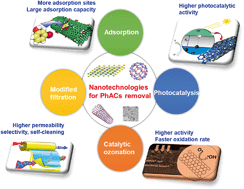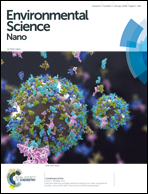Application of nanotechnologies for removing pharmaceutically active compounds from water: development and future trends
Abstract
Pharmaceutically active compounds (PhACs) are widely detected emerging contaminants in water environments and possess high potential risks to human health and aquatic life; however, conventional water treatment processes cannot remove them sufficiently. The boom in nanoscience and nanotechnology offers opportunities to leapfrog on the back of these new technologies to develop innovative techniques in the field of water treatment. The extraordinary properties of nanomaterials, such as large surface area, quantum effect, electrochemical and magnetic properties, and other size-dependent physical and chemical properties, offer nanotechnologies great advantages over conventional technologies. To date, nanomaterials have been extensively applied or investigated in adsorption, photocatalysis, catalytic ozonation and filtration processes and have been shown to have many promising potential application prospects. Among the various nanomaterials, graphene and carbon nanotubes have shown a superior adsorption capacity for the removal of PhACs and possess great potential for modifying photocatalysts; moreover, they can also act as highly efficient catalysts for ozonation. The nano-sized photocatalysts, i.e. nano-TiO2, graphitic carbon nitride, MoS2 nanosheets, and ZnO, generally exhibit higher photocatalytic activity than bulk photocatalysts. The involvement of nanomaterials in a membrane can improve the permeability, selectivity, and anti-fouling properties of the membrane for improved filtration processes. However, some challenges, such as high cost, poor separation performance and environmental risks, are still impeding their engineering application. Aiming to provide readers with a comprehensive insight into the application of nanotechnologies for PhACs' remediation, the current review summarizes the recent advances and breakthroughs made in nanotechnology for PhACs' removal, highlights the modification methods for improving the effectiveness of treatment methods using nanomaterials, and proposes a number of possible further research directions.

- This article is part of the themed collection: Best Papers 2018 – Environmental Science: Nano


 Please wait while we load your content...
Please wait while we load your content...